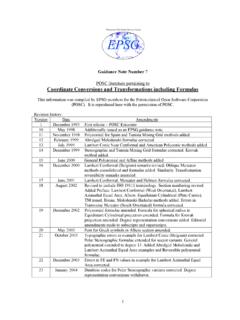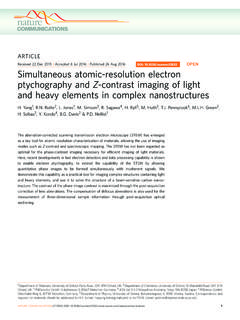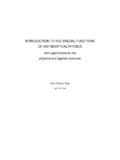Transcription of Stokes' Law Settling Velocity (Deposition)
1 1 Settling Velocity ( deposition ) Stokes' Law the drag on a spherical particle in a fluid is described by Stokes' Law for the following conditions: fluid is a Newtonian incompressible fluid duk/dxk=0 gravity is negligible g=0 flow is creeping flow, Re<<1 duk/dxk=0 steady-state flow duj/dt=0 Navier-Stokes Equation Bird, Stewart and Lightfoot, 1960 for j=1, 2, here we will neglect gravity so that the last term is dropped, and we will make dimensionless using characteristic Velocity u0 and length l where Re= ul/ =(inertial fluid forces)/(viscous fluid forces) l=diameter =density = =fluid viscosity u=mean speed of the undisturbed flow upstream of the body uj t+uk uj xk# $ % & ' ( = p xj+ 2uj xk xk+ gj uj* t+uk* uj* xk*# $ % & ' ( = p* xj*+1Re 2uj* xk* xk*Navier-Stokes Equation Stokes' solution with the assumptions: infinite medium rigid sphere no slip at the surface of the sphere so that in spherical coordinates we get the following velocities uk* uk* xk*=0 p* xj*=1Re 2uj* xk* xk* ur=u 1 32 Rpr# $ % & ' +12 Rpr# $ % & ' 3( ) * + , - cos u =u 1 34 Rpr$ % & ' ( 14 Rpr$ % & ' ( 3) * +.)))
2 Sin p=p0 32 u Rp# $ % & ' ( Rpr# $ % & ' 2cos Drag drag force consists of 2 components normal force - pressure on the solid acting perpendicularly to the surface at each point on the surface of the sphere; integrating around the sphere the normal force at any point (-pcos ), the total normal force becomes tangential force - shear stress caused by the Velocity gradient in the vicinity of the surface Fdrag=Fn+Ft if gravity 0 then Ftotal=Fdrag+Fbuoyant if flow and gravity directions coincide then for Re~1, inertial forces increase the drag force predicted by Stokes law Fn= pr=Rpcos ()0 02 Rp2sin d d =2 Rpu Ft= r r=Rpsin ()0 02 Rp2sin d d =4 Rpu =6 Rpu Fbuoyant= Dp3 g6 examples of Reynolds numbers of particles of varied diameters in air at p=1 atm, T=20 C.)
3 For particles in any range of Reynolds number we can describe the drag force in terms of an empirical coefficient and particle projected area (Ap): any shape Fdrag=CDAp (u2/2) spherical particles Fdrag= CDDp2 u2/8 Dp ( m) Re 20 60 100 2 300 20 with drag coefficient is given by CD=24/Re Re< =(24/Re)[1+3Re/16+9Re2ln(2Re)/160] <Re<2 =(24/Re)[1+ ] 2<Re<500 = {Stokes' Law} 500<Re<2x105 Eq. 2 force balance on the particle let the applicable forces be gravity and drag assume Re< such that CD=24/Re characteristic relaxation time, time scale required for the approach to steady motion terminal Velocity of the particle in this fluid, vt, where the particle has reached steady state mpdvdt=Fii mpdvdt=mpg+3 DpCcu v() =mpCc3 Dp dvdt+v=u Dp ( m) (sec) vt (m sec-1) for unit density spheres in air at 20oC vt= gDiffusivity gas A (carrier fluid) molecule particle gas B (second vapor)
4 Molecule binary diffusivity using the Chapman-Enskog theory and the hard-sphere approximation DAB = ( AB cA)(3 /32)(1+z) [cm2 sec-1] cf. Eq. , Settling Velocity terminal Velocity of the particle in this fluid, vt, where the particle has reached steady state Dp ( m) (sec) vt (m sec-1) for unit density spheres in air at 20oC Junge et al., 1961 Summary of Corrections to Stokes' Drag Force Name Drag coefficient Cunningham correction factor or friction factor Relative Magnitude Factual > FStokes Factual < FStokes Range Re= uDp/ > Kn=2 /Dp 1 Applicable Values Dp large, u large, large, or small Dp small or large Definition CD=Fdrag/(Ap (u2/2)) Cc=3 uDp/Fdrag Factor CD (non-creeping) [part.]
5 Vel.] Cc or f (non-continuum) [size] Correction CD=(24/Re), Re< CD=(24/Re)[1+3Re/16+9Re2ln(2Re)/160], <Re<2 CD=(24/Re)[1+ ]. 2<Re<500 CD= , 500<Re<2x105 Cc=1+Kn[ + ( )], or for air at STP Cc=1+( )2 /Dp, Dp>> Cc=1+( )2 /Dp, Dp<< Characteristic Length Scales Knudsen number - ratio of the length scale of molecular motion in the fluid phase to the length scale of the particle; this ratio describes how the fluid "views" the particle, is the motion governed by the rules of molecules or of macroscopic objects Kn = 2 /Dp= (fluid "graininess")/(particle radius) Mean speed of gas molecules c c c 3 Mean Free Path Mean free path of gases mean free path - air, the average distance traveled between collisions with other gas molecules.
6 AB is the average distance traveled by a molecule of A before it encounters a molecule of B (for Z collisions) = c/Z; c = (8kT/ m) Mean free path in particle evolution processes coagulation, deposition : diffusion of particles in air, use air condensation: diffusion of another gas (B) to a particle in air, use AB Eq. , Regimes of Particle Motion continuum regime Kn << 1 Dp exceeds air , so air appears to the particle as a continuum, and the laws of continuum mechanics apply transition regime Kn 1 air and Dp are of the same order of magnitude, so transport is controlled by both continuum mechanics and kinetic theory free molecule regime Kn >> 1 air exceeds Dp, so transport controlled by the kinetic theory of gases air Dp air Dp air air Dp Dp air air Dp Dp Slip Correction continuum regime Kn << 1 (Kn< ) No slip condition holds transition regime Kn 1 ( <Kn<10)
7 Slip correction is required free molecule regime Kn >> 1 (10<Kn) Drag force is smaller than predicted by Stokes air Dp air Dp air air Dp Dp air air Dp Dp Cunningham Correction Factor continuum regime Kn << 1 (Kn< ) No slip condition holds transition regime Kn 1 ( <Kn<10) Slip correction is required free molecule regime Kn >> 1 (10<Kn) Drag force is smaller than predicted by Stokes Dp ( m) Cc Junge and Gustaffson, 1957 Junge et al., 1961 How spherical are real particles? 4 Particle Size and deposition Sizes Particle Size Distributions (defining size ) How to Calculate Mean Particle Size Microphysics deposition Velocity (depends on size) How to Calculate Particle Lifetime Bonus.
8 How to Calculate Particle Loss in a Tube Aerosol Composition Chemical composition gives an indication of particle sources C, N, S contributions to composition illustrate role of aerosols in biogeochemical cycles Classification of Pollutants Fine Particles less than m in diameter Coarse Particles greater than m in diameter Particle Types and size (microns)Bacteria Black Carbon (Soot) Tobacco Smoke Viruses Gas Molecules Size Range for Particle Sources Particle Type Size Range automotive emissions m to 1 m bacteria m to 10+ m tobacco smoke m to 1 m viruses m to m Particle Types and their Removal Flagan and Seinfeld, 1986





